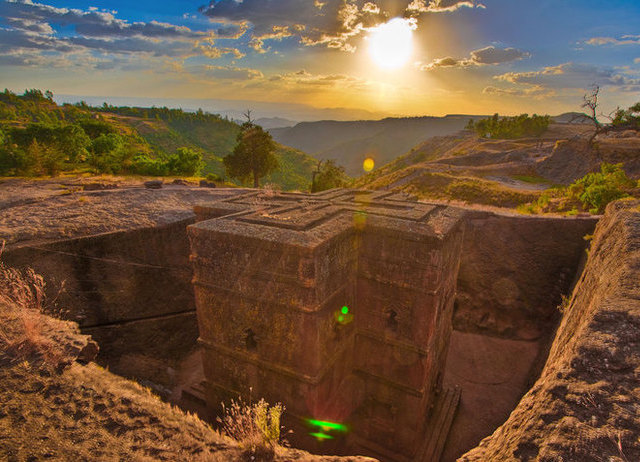 Bete Giyorgis, one of the rock-hewn churches of Lalibela. (Photograph: UNESCO World Heritage Centre)
Bete Giyorgis, one of the rock-hewn churches of Lalibela. (Photograph: UNESCO World Heritage Centre)
Tadias Magazine
By Tadias Staff
Published: Monday, May 26th, 2014
New York (TADIAS) — It has been over 800 years since Emperor Lalibela of Ethiopia oversaw the construction of the world-famous monolithic rock churches that bear his name, but to this day the buildings’ unique architecture continue to inspire awe far beyond the country’s borders.
In a recent article entitled The 19 Most Stunning Sacred Places Around the World, the Huffington Post highlights Lalibela as one of the globe’s jaw-dropping and revered places to visit – a list that also includes the Saint-Michel d’Aiguilhe Chapel in France, the Golden Pagoda in Myanmar (Burma) perched above the former capital Rangoon, as well as the flower-shaped Lotus Temple in India.
Lalibela was built in the late 12th and early 13th Century and legend has it that it stands as a symbolic representation of old Jerusalem that had fallen into the hands of the Muslim leader Saladin in autumn of 1187. The United Nations Educational, Scientific and Cultural Organization (UNESCO) declared Lalibela a World Heritage Site in 1978 stating “Lalibela is a high place of Ethiopian Christianity, still today a place of devotion.”
The Huffington Post focuses on Bete Giyorgis (House of St. George), the most photographed of Lalibela’s 11 churches. “Bete Giyorgis is a 12th-century church carved directly into the rock around Lalibela, Ethiopia,” the publication notes. “Bete Giyorgis, though, is just the most famous of 11 churches carved into the bedrock originally designed to emulate Jerusalem. Travelers can explore this most unique of holy sites via winding tunnels and passageways dozens of feet below surface level.”
UNESCO adds: “The King of Lalibela set out to build a symbol of the holy land, when pilgrimages to it were rendered impossible by the historical situation. In the Church of Bete Golgotha, are replicas of the tomb of Christ, and of Adam, and the crib of the Nativity. The holy city of Lalibela became a substitute for the holy places of Jerusalem and Bethlehem, and as such has had considerable influence on Ethiopian Christianity. The Jerusalem theme is important. The rock churches, although connected to one another by maze-like tunnels, are physically separated by a small river which the Ethiopians named the Jordan. Churches on one side of the Jordan represent the earthly Jerusalem; whereas those on the other side represent the heavenly Jerusalem, the city of jewels and golden sidewalks alluded to in the Bible.”
Click here to read The 19 Most Stunning Sacred Places Around the World at Huffington Post.
—
Join the conversation on Twitter and Facebook.

























